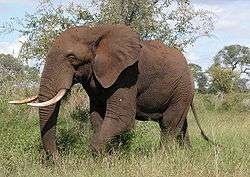Proboscidea
| Proboscidea Temporal range: Paleocene-Holocene 60.0–0 Ma | |
|---|---|
 | |
| African bush elephant, Loxodonta africana | |
| Scientific classification | |
| Kingdom: | Animalia |
| Phylum: | Chordata |
| Clade: | Synapsida |
| Class: | Mammalia |
| Clade: | Tethytheria |
| Order: | Proboscidea Illiger, 1810 |
| see below | |
|
Elephantidae | |
The Proboscidea (from the Greek προβοσκίς and the Latin proboscis) are a taxonomic order of afrotherian mammals containing one living family, Elephantidae, and several extinct families. This order, first described by J. Illiger in 1811, encompasses the trunked mammals.[1][2] Later proboscideans are distinguished by tusks and long, muscular trunks; these features are less developed or absent in early proboscideans. Proboscidea may have produced the largest land mammal of all time in the form of Palaeoloxodon namadicus, which may have weighed up to 22 t (24 short tons), with a shoulder height of up to 5.2 metres (17 ft), surpassing several sauropod dinosaurs.[3]
The earliest known proboscidean is Eritherium,[4] followed by Phosphatherium, a small animal about the size of a fox. These both date from late Paleocene deposits of Morocco.
Proboscideans diversified during the Eocene and early Oligocene. Several primitive families from these epochs have been described, including Numidotheriidae, Moeritheriidae, and Barytheriidae in Africa. (Anthracobunidae from the Indian subcontinent has also been included, but was excluded from Proboscidea by Shoshani & Tassy (2005)[5] and has more recently been assigned to Perissodactyla.[6]) These were followed by the earliest Deinotheriidae, or "hoe tuskers", which thrived during the Miocene and into the early Quaternary. Proboscideans from the Miocene also included Stegolophodon, an early genus of the disputed family Stegodontidae; the diverse family of Gomphotheriidae, or "shovel tuskers", such as Platybelodon and Amebelodon; and the Mammutidae, or mastodons.
Most families of Proboscidea are now extinct, many since the end of the last glacial period. Recently extinct species include the last examples of gomphotheres in Central and South America, the American mastodon of family Mammutidae in North America, numerous stegodonts once found in Asia, the last of the mammoths, and several island species of dwarf elephants.[7]
Classification
- Proboscidea
- incertae sedis †Moeritheriidae
- †Plesielephantiformes
- Elephantiformes
- †Palaeomastodontidae
- †Phiomiidae
- Elephantimorpha
- incertae sedis †Eritreum [8]
- †Hemimastodontidae
- †Mammutida (mastodons)
- Elephantida
References
- ↑ Vergiev, S.; Markov, G. (2010). "A mandible of Deinotherium (Mammalia - Proboscidea) from Aksakovo near Varna, Northeast Bulgaria". Palaeodiversity. 3: 241–247.
- ↑ "Proboscidea". Retrieved 13 September 2011.
- ↑ Larramendi, A. (2016). "Shoulder height, body mass and shape of proboscideans" (PDF). Acta Palaeontologica Polonica. 61. doi:10.4202/app.00136.2014.
- ↑ Gheerbrant, E. (2009). "Paleocene emergence of elephant relatives and the rapid radiation of African ungulates". Proceedings of the National Academy of Sciences. 106 (26): 10717–10721. doi:10.1073/pnas.0900251106. PMC 2705600
 . PMID 19549873.
. PMID 19549873. - ↑ Shoshani, Jeheskel; Pascal Tassy (2005). "Advances in proboscidean taxonomy & classification, anatomy & physiology, and ecology & behavior". Quaternary International. 126-128: 5–20. doi:10.1016/j.quaint.2004.04.011.
- ↑ Cooper, L. N.; Seiffert, E. R.; Clementz, M.; Madar, S. I.; Bajpai, S.; Hussain, S. T.; Thewissen, J. G. M. (2014-10-08). "Anthracobunids from the Middle Eocene of India and Pakistan Are Stem Perissodactyls". PLoS ONE. 9 (10): e109232. doi:10.1371/journal.pone.0109232. PMC 4189980
 . PMID 25295875.
. PMID 25295875. - ↑ Bjorn Kurten, Elaine Anderson (17 May 2005). Pleistocene mammals of North America - Google Books. Google Book Search. Retrieved 1 July 2009.
- ↑ Shoshani, Jeheskel; Robert C. Walter; Michael Abraha; Seife Berhe; Pascal Tassy; William J. Sanders; Gary H. Marchant; Yosief Libsekal; Tesfalidet Ghirmai; Dietmar Zinner (2006). "A proboscidean from the late Oligocene of Eritrea, a "missing link" between early Elephantiformes and Elephantimorpha, and biogeographic implications". PNAS. 103 (46): 17296–17301. doi:10.1073/pnas.0603689103.
Bibliography
- Ronald M. Nowak (1999), Walker’s Mammals of the World (6 ed.), Baltimore: Johns Hopkins University Press, ISBN 0-8018-5789-9, LCCN 98023686
| Wikimedia Commons has media related to Proboscidea. |
| Wikispecies has information related to: Proboscidea |
| The Wikibook Dichotomous Key has a page on the topic of: Proboscidea |
| Look up Proboscidea in Wiktionary, the free dictionary. |
